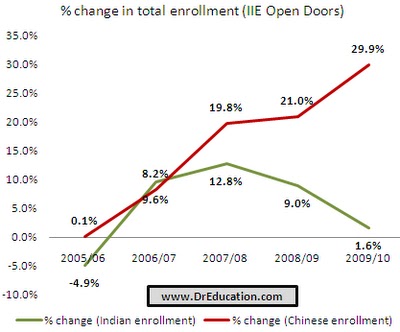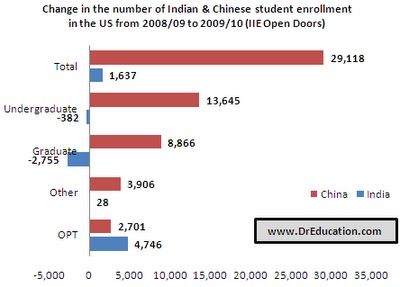After eight consecutive years as the leading country of origin for international students in the United States, India was overtaken by China in the last academic year, and by a large margin. Two years of double-digit enrollment growth and an eye-popping 30 percent surge in enrollments from China last year – combined with slower comparative growth from India – meant that there were 22,731 more Chinese students than Indians enrolled in U.S. institutions of higher education in academic year 2009/10, according to recently released data from the Institute for International Education [1].
At the graduate level this year, a similar story played out, with the number of offers of admission and total first-time enrollments of Indian students decreasing for the third year in a row (by 4 percent and 3 percent respectively), according to data from the Council of Graduate Schools. This comes despite continued interest among Indian graduate students who applied to U.S. programs in slightly higher numbers this year than they did last year.
As the numbers above indicate, trends in enrollments of Chinese and Indian students have been diverging sharply in recent years. There were 3,137 less Indian students enrolled in graduate and undergraduate programs in the last academic year compared to 2008/09, which is in contrast to 22,511 more Chinese students (IIE Open Doors 2010 [2]). These contrasting figures exclude data on Optional Practical Training [3] (OPT) and “Other” non-degree categories and therefore reveal the real enrollment change in degree programs for the 2009/10 academic year.
Over the last five years, from 2004/05 to 2009/10, the pace of growth among Chinese student enrollments was nearly three times (compounded growth rate of 15.3 percent) that of Indian enrollments (5.5 percent). The total number of Chinese students doubled from 62,523 in 2004/05 to 127,628 in 2009/10, resulting in an increase of 65,105 students in five years. During the same period, the number of Indian student enrollments grew at a much slower rate, adding just 24,431 more students in 2009/10 as compared to 2004/05, albeit from a higher starting point. It should also be noted that much of the recent growth in Indian enrollments has come in the OPT category.
OPT is masking the real decline in Indian students
The Open Doors data show 1.6 percent growth in enrollments among Indian students, which translates to 1,637 additional students as compared to last year. Digging a little deeper and analyzing the break-up by academic level, it becomes clear that Indian students have only grown in the OPT category. The number of post-graduation Indian students on OPT increased by 4,746 while the number of students enrolled in degree programs decreased by 3,137 students, giving a misleading impression of growth in total enrollment.
This significant increase in the number of Indian students undertaking OPT is a direct effect of a successful U.S. policy initiative that allows for the extension of OPT from the regular 12 months to 29 months [6] in science, technology, engineering and mathematics (STEM) fields. This rule came into effect in April 2008 and its adoption increased significantly with the economic recessionary cycle. Given that 57 percent of all Indian students are enrolled in engineering and computer science programs, which qualify for the 29-month OPT rule, many Indian students are seeking out OPT opportunities with U.S. employers. Under this arrangement, students are technically “enrolled” in an academic program with an F-1 visa and hence included in the IIE Open Doors numbers.
Where are Indians going?
The United Kingdom has been the biggest net gainer of Indian students. Enrollment of Indian students in the United Kingdom increased by 8,160 in the period 2007-08 to 2008-09 ( Universities UK). By contrast, enrollment of Chinese students in the United Kingdom increased by just 1,680 over the same timeframe. More recently, U.K. visa statistics [7] for 2010 admissions indicate a significant increase in interest in U.K. universities among Indian students. This can be attributed to three interrelated factors.
1) The Australia effect
Concerns over safety [8] resulted in nearly 5,000 fewer students enrolling in Australian higher education (excluding VET and English language) in September 2010 as compared to last year. However, total enrollments and commencements (new enrollments) declined by nearly 20 percent and 48 percent respectively. A lot of this traffic has been redirected to the United Kingdom and Canada, but to a lesser extent the United States.
2) US universities didn’t gain from Australia’s loss
Universities in the United States gained little from the redirecting of Indian-student traffic from Australia. A major reason for this may be related to the declining acceptance rate of Indian students by U.S. universities and colleges caused by an over-concentration of Indian students in particular fields and levels of study. By way of example, a total of 57 percent of all Indian students were enrolled in engineering, computer science and business at the master’s level in 2009 (NSF [9]), as compared to 24 percent among Chinese students. Because these programs already receive a large number of applications from India, and due to limited differentiation offered by applicants, universities have to decline Indian students at a higher rate. This in turn is a result of the very narrow set of technology- and business-focused institutions that Indian students tend to apply to. Indian students also tend to rely heavily on assistantships and these are currently much harder to get because of the budgetary crisis of U.S. public universities. See a detailed analysis here [10].
3) Aggressive recruitment strategies by U.K. universities
Universities and colleges in the United Kingdom have been using aggressive recruitment strategies, such as the use of agents and representative offices in India, for much longer than U.S. universities, which are just beginning to employ such strategies. For example, the University of Bedfordshire [11] which enrolls approximately 1,700 Indian students, uses an extensive network of agents and representative office to counsel and recruit students. Likewise, the University of Warwick has representative offices, while the University of Salford has multiple agent engagements. Meanwhile, the debate is still very much open in the United States as to whether the use of paid agents is ethically acceptable for international recruitment.
Why are Indian and Chinese mobility patterns changing?
There are many reasons for the differences in the enrollment patterns of Chinese and Indian students, however, three key reasons relate to size of education systems, ability to afford education, and future career expectations/options.
The supply of students seeking foreign education is higher in China than in India. China has about 27 million students enrolled in tertiary education as compared to 15 million for India (Global Education Digest).
The Chinese have nearly double the purchasing power of Indians (World Bank) and Chinese students also get more concentrated support as a single child in their family. This helps them pursue business programs which are expensive and offer little financial aid as compared to engineering where assistantships are more readily available.
Given the growth of the information technology services industry, Indians see engineering as an attractive career option with opportunities of long-term settlement in the United States. In addition, career opportunities in India are diverting potential graduate students from academia to the workplace.
Graduate opportunities at UK universities are becoming more popular among Indian students because of better return on investments from the shorter one-year master’s program.
Conclusion
The trend for fall 2011 admissions is likely to be quite similar to 2009/10 with the United Kingdom and Canada continuing to attract traffic from the United States and Australia. For the fall 2012 admissions cycle, if the U.S. economy has sufficiently stabilized and Australia has overcome it’s public relations issues with Indian students then the prospect for renewed growth looks positive, especially if proposed immigration reforms in the UK make it less attractive. Other European master’s programs are likely to gain traction, and Canada will attract talent by leveraging immigration and funding policies.
Overall, Indians will continue to seek opportunities to study abroad and will be more open to explore alternative destinations. The United States will remain the leading destination by a large margin, however its preeminence over the longer term is less assured.


